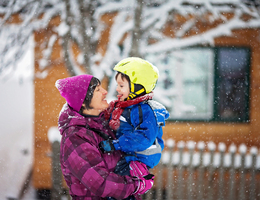
A helmet? For sledding?
It's not such a bad idea, according to the American Academy of Orthopaedic Surgeons (AAOS).
To keep sledding safe and fun, the AAOS recommends that children younger than 12 wear helmets and that no one sled in the street.
Young children are highly vulnerable to head injuries, says the AAOS. They have higher centers of gravity and proportionately larger heads than older kids. And their coordination is not fully developed, so they have difficulty in preventing themselves from falling.
The AAOS and the National Safety Council recommend these safe-sledding tips for people of all ages:
Know your hill. Does it end on a street or parking lot? In a pond or puddle? Are there rocks, stumps or trees in your path? Take a close look at any hill before you sled down it, especially if you've never sledded there before.
Go for the snow. You should sled on snow, not ice. Icy conditions can reduce your control while increasing your speed.
Avoid motorized vehicles. Never ride in a sled being pulled by a car or truck.
Pick a safe sled. Look for sturdy construction, secure handholds and an easy way to steer. Avoid sleds with sharp, jagged edges or metal parts that stick out.
Wait your turn. To prevent collisions at the bottom of the hill, wait until the last sledder has moved out of the way to head down the hill.
Avoid sledding in the dark. The hill needs to be well-lit so you can see where you're going.
Face forward. Sitting up, facing forward is the safest position for sledding. That way you can see where you're going and spot anything that's in your path.
Bundle up. If you're not dressed properly while sledding, you risk frostbite. In addition to mittens, jackets and boots, ski masks can help protect you from the wind and keep your face toasty warm.
Learn how to stop. Make sure you know how to stop the sled or get off quickly in an emergency.
Reviewed 10/31/2023
Sources
- American Academy of Orthopaedic Surgeons. "5 Ways to Protect Yourself from Cold Weather Injuries. https://www.aaos.org/aaos-home/newsroom/press-releases/5-ways-to-protect-yourself-from-cold-weather-injuries/
- National Safety Council. "Slippery Slope: Take Care to Prevent Sledding Injuries. https://www.nsc.org/community-safety/safety-topics/seasonal-safety/winter-safety/sledding?
- OrthoInfo. "Sledding Injury Prevention." https://orthoinfo.aaos.org/en/staying-healthy/sledding-injury-prevention